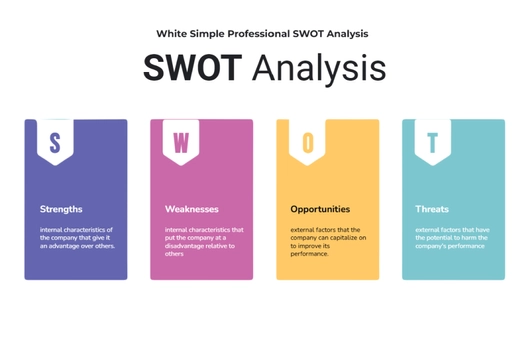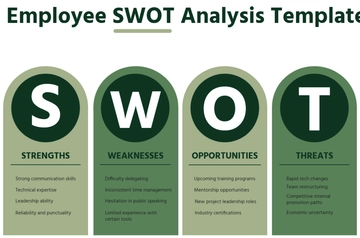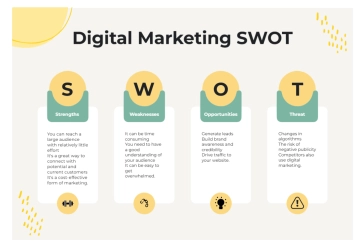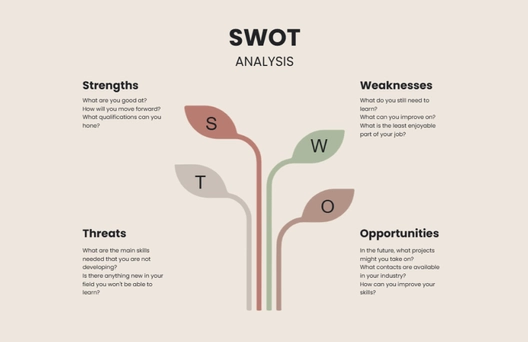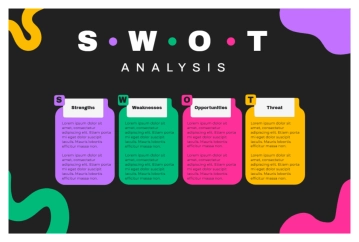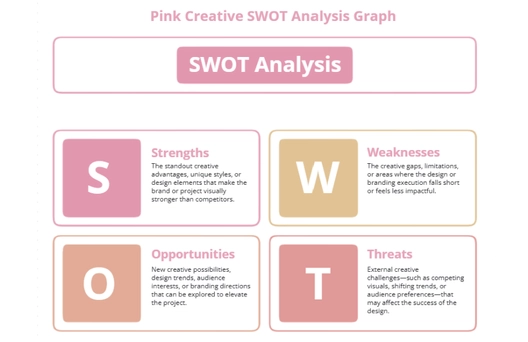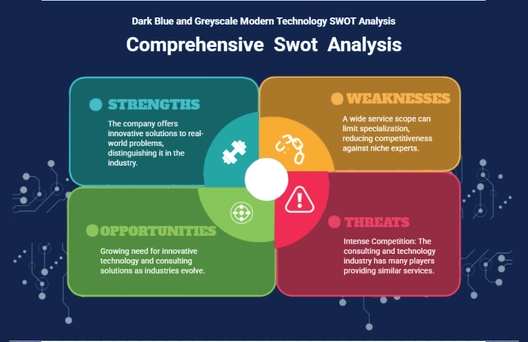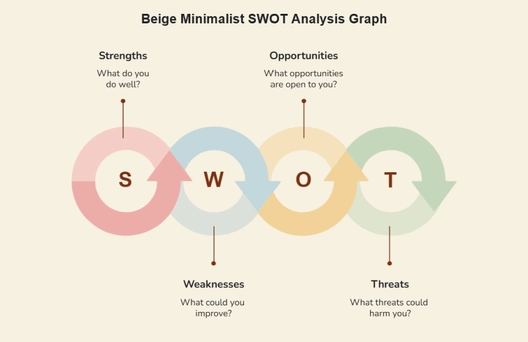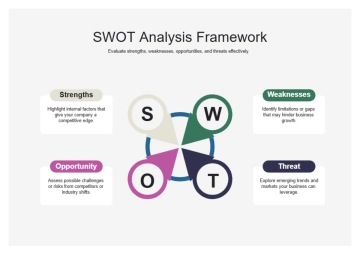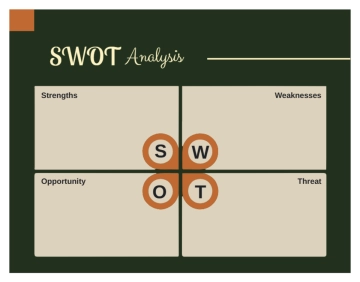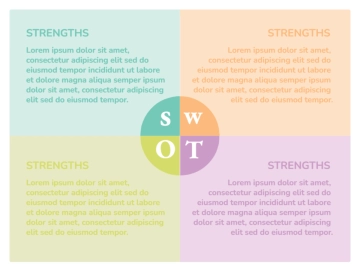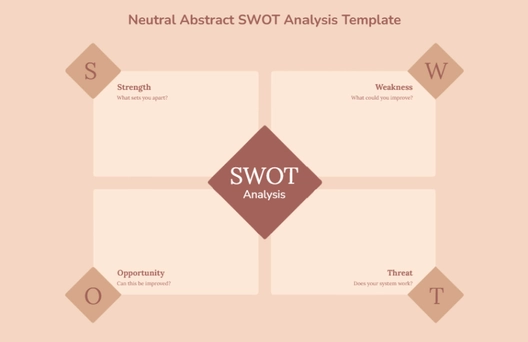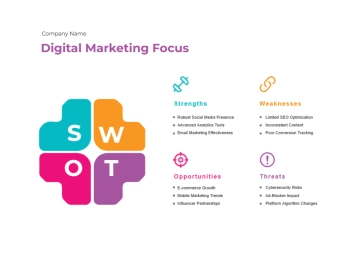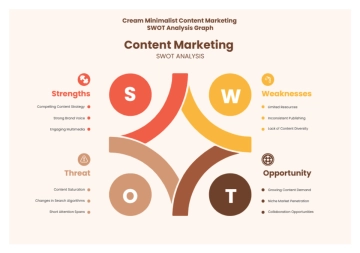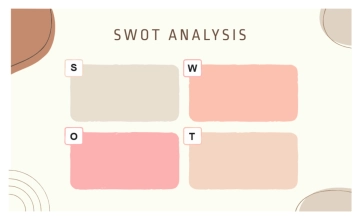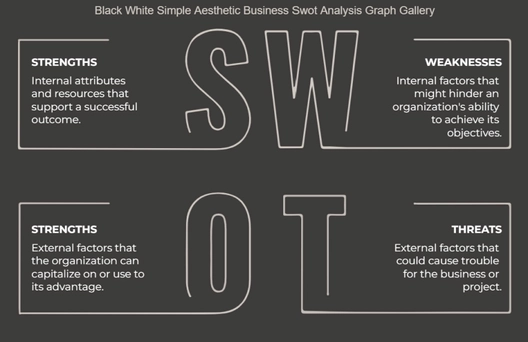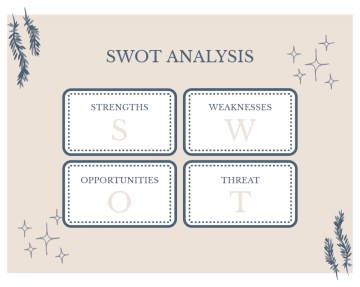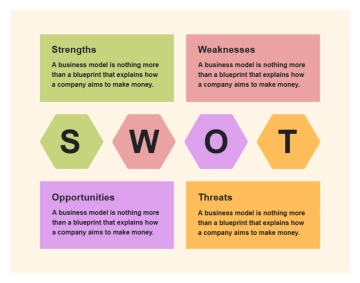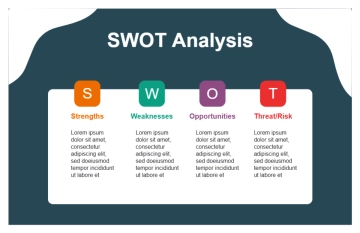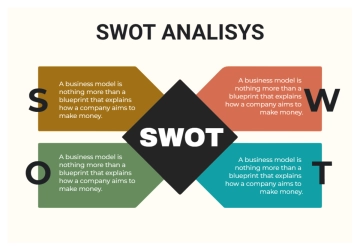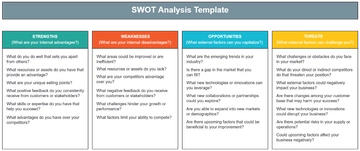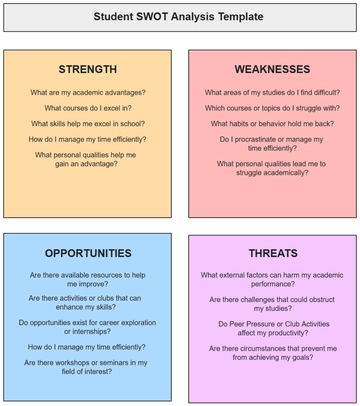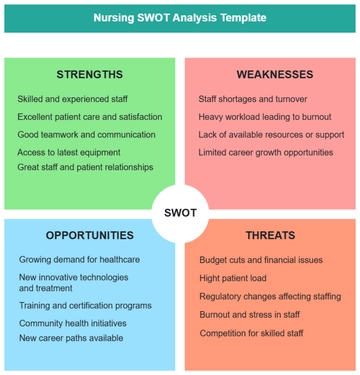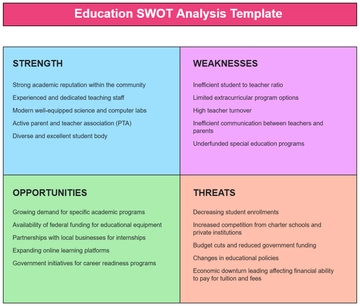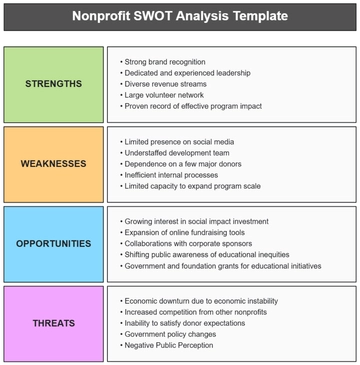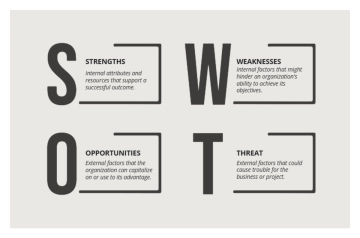Free Hotel SWOT Analysis

I. Executive Summary
[Your Company Name], established as a premier hotel brand in the industry, prides itself on offering luxurious accommodations and exceptional service. With locations strategically placed in key urban centers and popular tourist destinations, the company has achieved a robust occupancy rate averaging 85% annually. This success is underpinned by our commitment to quality, customer satisfaction, and continuous innovation.
Our SWOT analysis reveals a strong market position supported by a loyal customer base and high brand recognition. However, it also identifies potential vulnerabilities, such as dependency on seasonal tourism and economic fluctuations. By understanding these strengths, weaknesses, opportunities, and threats, we can strategize effectively to enhance our competitive edge and sustain long-term growth.
This comprehensive analysis will delve into various aspects of our operations, providing detailed insights into our internal capabilities and external environment. The aim is to craft strategies that leverage our strengths and opportunities while mitigating risks associated with our weaknesses and external threats.
II. Introduction
A. Purpose
The purpose of this SWOT analysis is to provide a strategic framework that identifies the internal and external factors affecting [Your Company Name]. By evaluating these elements, we aim to develop strategies that maximize our strengths and opportunities while addressing our weaknesses and potential threats.
B. Methodology
This analysis was conducted using a combination of qualitative and quantitative data sources, including customer feedback, market trends, and financial reports. The SWOT framework categorizes these findings into four key areas: Strengths, Weaknesses, Opportunities, and Threats.
C. Scope
The scope of this analysis covers all operational aspects of [Your Company Name], including marketing, customer service, financial performance, and competitive positioning. It also considers broader industry trends and economic factors that could impact our business.
III. Strengths
A. High Brand Recognition
Strong Market Presence: [Your Company Name] has established a significant presence in the hospitality industry, known for its luxurious accommodations and impeccable service. This reputation attracts a loyal customer base and encourages repeat business, solidifying our market position and driving consistent revenue growth.
Loyal Customer Base: Our extensive loyalty program rewards frequent guests, fostering customer retention and long-term brand loyalty. This program has been instrumental in maintaining high occupancy rates and consistent revenue streams, as it encourages repeat visits and word-of-mouth referrals.
Innovative Marketing Strategies: Utilizing a mix of digital and traditional marketing channels, we effectively reach our target audience, enhancing brand visibility and engagement. These strategies include social media campaigns, influencer partnerships, and targeted promotions that resonate with our diverse customer segments and drive bookings.
B. Exceptional Customer Service
Comprehensive Training Programs: We invest in rigorous training programs for our staff, ensuring they provide exceptional service that meets and exceeds guest expectations. This commitment to service excellence differentiates us from competitors and fosters a culture of continuous improvement.
Personalized Guest Experiences: By leveraging customer data and feedback, we tailor experiences to individual preferences, enhancing guest satisfaction and encouraging positive reviews and referrals. This personalized approach not only delights our guests but also builds strong emotional connections with our brand.
Rapid Response to Feedback: Our proactive approach to addressing customer feedback and resolving issues promptly ensures a high level of guest satisfaction and trust in our brand. This responsiveness demonstrates our commitment to guest well-being and helps mitigate potential negative impacts on our reputation.
C. Financial Stability
Strong Revenue Growth: Consistent year-over-year revenue growth demonstrates our financial health and effective management practices. This stability enables us to invest in property upgrades and new ventures, ensuring our continued competitiveness and market leadership.
Diverse Revenue Streams: In addition to room bookings, we generate revenue through food and beverage services, event hosting, and spa offerings. This diversification helps mitigate risks associated with market fluctuations and provides a steady income stream across different economic cycles.
Efficient Cost Management: Our focus on cost control and operational efficiency ensures profitability while maintaining high service standards. This disciplined approach to expense management allows us to reinvest savings into enhancing guest experiences and expanding our portfolio.
D. Prime Locations
Strategic Urban Locations: Our hotels are strategically located in major cities and tourist destinations, attracting a diverse clientele, from business travelers to vacationers. These prime locations enhance our visibility and accessibility, driving consistent foot traffic and bookings.
High Accessibility: Proximity to key transport hubs such as airports and train stations enhances convenience for our guests, contributing to our competitive advantage. Easy access to transportation options makes our properties a preferred choice for both domestic and international travelers.
Scenic and Iconic Sites: Many of our properties are situated in scenic or iconic locations, offering guests unique and memorable experiences that add to our brand's appeal. These exceptional settings provide a strong selling point that differentiates us from competitors and attracts a premium clientele.
IV. Weaknesses
A. Dependency on Seasonal Tourism
Fluctuating Occupancy Rates: Our occupancy rates vary significantly with the seasons, leading to inconsistent revenue streams. Peak seasons generate high income, while off-peak periods can result in lower occupancy and financial strain, necessitating adaptive pricing and marketing strategies.
Increased Operational Costs: Managing fluctuations in occupancy requires adaptive staffing and resource allocation, which can increase operational costs and complexity. Balancing these costs while maintaining service quality is a continuous challenge.
Limited Off-Season Appeal: Some of our locations lack attractions or activities that draw visitors during off-peak times, limiting our ability to maintain consistent occupancy year-round. Developing off-season packages and promotions is essential to addressing this weakness.
B. High Operational Costs
Maintenance and Upgrades: Maintaining the luxurious standards of our properties requires significant investment in regular maintenance and upgrades, contributing to high operational costs. These expenses are necessary to preserve our brand's reputation but must be carefully managed to ensure profitability.
Labor Costs: Providing exceptional service necessitates a skilled and well-compensated workforce, leading to substantial labor costs, especially in markets with higher living expenses. Retaining top talent while controlling labor expenses is a key operational challenge.
Energy and Utility Expenses: Operating large facilities with extensive amenities results in high energy and utility expenses, impacting our overall profitability. Implementing energy-efficient solutions can help mitigate these costs and support our sustainability goals.
C. Limited Brand Diversification
Concentration in Luxury Segment: Our primary focus on the luxury segment limits our market reach, making us vulnerable to economic downturns that affect discretionary spending. Diversifying our offerings can help mitigate this risk and attract a broader customer base.
Niche Market Appeal: Catering predominantly to high-end travelers restricts our ability to attract a broader customer base, potentially limiting growth opportunities in other segments. Expanding into mid-range or budget segments could provide new revenue streams.
Brand Perception: While our luxury positioning is a strength, it may also create a perception of exclusivity that deters some potential customers. Developing sub-brands or new concepts can help address different market needs without diluting our core brand.
D. Vulnerability to Economic Fluctuations
Economic Sensitivity: The luxury hospitality market is highly sensitive to economic conditions, with downturns leading to reduced travel and discretionary spending by consumers. Implementing flexible pricing strategies and targeting diverse market segments can help mitigate this vulnerability.
Impact of Exchange Rates: Fluctuations in exchange rates can affect international travel patterns and spending, impacting our revenue, especially in locations popular with foreign tourists. Hedging strategies and dynamic pricing can help manage this risk.
Inflationary Pressures: Rising costs of goods and services due to inflation can squeeze profit margins, necessitating price adjustments that may affect demand. Monitoring cost trends and optimizing operational efficiency are crucial to maintaining profitability.
V. Opportunities
A. Expansion into Emerging Markets
Untapped Markets: There are significant growth opportunities in emerging markets where demand for luxury accommodations is rising. Expanding into these areas can diversify our revenue sources and reduce dependence on established markets. Strategic market entry and local partnerships are key to success.
Local Partnerships: Forming strategic partnerships with local businesses and tourism boards can enhance our market entry and operational success in new regions. Collaborations with local stakeholders can provide valuable insights and support.
Tailored Services: Developing culturally tailored services and amenities can enhance our appeal and competitiveness in emerging markets. Understanding and respecting local customs and preferences is essential for building strong customer relationships.
B. Technological Advancements
Enhanced Customer Experience: Leveraging technology such as AI and IoT can improve guest experiences through personalized services, automated check-ins, and smart room features. These innovations can increase guest satisfaction and differentiate our brand.
Operational Efficiency: Implementing advanced management systems can streamline operations, reduce costs, and enhance service delivery, contributing to higher guest satisfaction. Technology can also provide valuable data for decision-making.
Data Analytics: Utilizing data analytics to understand customer preferences and trends enables us to tailor marketing strategies and improve decision-making processes. Predictive analytics can help anticipate guest needs and optimize resource allocation.
C. Sustainable Practices
Eco-Friendly Initiatives: Investing in sustainable practices such as energy-efficient systems, waste reduction programs, and green building certifications can attract environmentally conscious travelers and reduce operational costs. Sustainability efforts also support our corporate social responsibility goals.
Corporate Social Responsibility: Strengthening our commitment to corporate social responsibility through community engagement and environmental stewardship can enhance our brand reputation and customer loyalty. These initiatives can create a positive impact on both local communities and the environment.
Government Incentives: Taking advantage of government incentives for sustainable practices can provide financial benefits and support our sustainability goals. These incentives can offset initial investment costs and promote long-term savings.
D. Enhanced Marketing Strategies
Digital Marketing: Expanding our digital marketing efforts through social media, content marketing, and targeted advertising can increase brand visibility and customer engagement. Digital channels offer cost-effective ways to reach a wide audience and drive bookings.
Influencer Partnerships: Collaborating with influencers and travel bloggers can amplify our brand reach and attract new customers through authentic endorsements and content. Influencers can provide valuable exposure and credibility.
Loyalty Programs: Enhancing our loyalty programs with personalized rewards and exclusive offers can boost customer retention and encourage repeat business. Loyalty programs can also provide valuable data for marketing and service improvements.
VI. Threats
A. Intense Competition
Market Saturation: The hospitality industry is highly competitive, with numerous established brands and new entrants vying for market share. Differentiating our offerings through unique experiences and superior service is crucial for maintaining our competitive edge.
Alternative Accommodations: The rise of alternative accommodations such as vacation rentals and homestays presents a significant threat, as they offer different experiences and price points. Adapting to changing consumer preferences and offering competitive pricing and unique amenities is essential.
Price Wars: Intense competition can lead to price wars, eroding profit margins and potentially compromising service quality. Developing value-added services and maintaining premium pricing through superior offerings can help mitigate this threat.
B. Economic Uncertainty
Global Economic Downturns: Economic recessions and downturns can significantly impact travel and discretionary spending, leading to reduced bookings and revenue. Implementing flexible pricing and cost-control measures can help navigate economic uncertainties.
Inflation and Exchange Rates: Fluctuations in inflation and exchange rates can affect costs and pricing strategies, impacting profitability. Monitoring economic indicators and adjusting pricing dynamically can help manage these risks.
Geopolitical Risks: Geopolitical instability and conflicts can deter travel and affect our operations in certain regions. Diversifying our market presence and developing contingency plans are essential for mitigating these risks.
C. Technological Disruptions
Cybersecurity Threats: The increasing reliance on technology exposes us to cybersecurity threats, which can compromise customer data and trust. Implementing robust cybersecurity measures and regular audits are critical for protecting our systems.
Technological Advancements: Rapid advancements in technology require continuous investment and adaptation to stay competitive. Keeping pace with technological trends and integrating relevant innovations into our operations is necessary for maintaining our market position.
Regulatory Changes: Changes in data privacy and security regulations can impact our operations and require significant compliance efforts. Staying informed of regulatory developments and ensuring compliance can mitigate potential legal and financial repercussions.
D. Health and Safety Concerns
Pandemics: Health crises such as pandemics can lead to travel restrictions, reduced bookings, and increased operational challenges. Implementing robust health and safety protocols and flexible booking policies can help manage these impacts.
Safety Standards: Maintaining high safety standards is critical to guest trust. Any lapses can result in negative publicity and loss of business. Regular training and adherence to safety regulations are essential for ensuring guest safety.
Natural Disasters: Natural disasters can disrupt operations, cause property damage, and deter travelers from affected regions, impacting our revenue and recovery costs. Developing comprehensive disaster preparedness plans and insurance coverage can help mitigate these risks.
VII. SWOT Analysis Summary
The following table summarizes the strengths, weaknesses, opportunities, and threats identified in this analysis:
Strengths | Weaknesses | Opportunities | Threats |
|---|---|---|---|
High Brand Recognition | Dependency on Seasonal Tourism | Expansion into Emerging Markets | Intense Competition |
Exceptional Customer Service | High Operational Costs | Technological Advancements | Economic Uncertainty |
Financial Stability | Limited Brand Diversification | Sustainable Practices | Technological Disruptions |
Prime Locations | Vulnerability to Economic Fluctuations | Enhanced Marketing Strategies | Health and Safety Concerns |
A. Strengths
The high brand recognition of [Your Company Name] positions it as a leader in the luxury hotel segment. Exceptional customer service, underpinned by comprehensive training programs and personalized guest experiences, is a cornerstone of our competitive advantage. Financial stability and diverse revenue streams ensure consistent growth and profitability. Our prime locations in major urban centers and scenic destinations enhance our appeal to a wide range of travelers.
B. Weaknesses
Dependency on seasonal tourism presents challenges in maintaining consistent occupancy rates throughout the year. High operational costs, driven by maintenance, labor, and utility expenses, impact our profitability. Limited brand diversification confines us to the luxury segment, making us vulnerable to economic fluctuations. The susceptibility to economic downturns, inflationary pressures, and exchange rate fluctuations further complicates our financial stability.
C. Opportunities
Expansion into emerging markets offers significant growth potential and diversification benefits. Technological advancements can enhance guest experiences and operational efficiency. Embracing sustainable practices aligns with growing consumer preferences and can reduce costs. Enhanced marketing strategies, particularly in digital channels, can increase brand visibility and customer engagement.
D. Threats
Intense competition in the hospitality industry and the rise of alternative accommodations pose significant challenges. Economic uncertainty, including global downturns and currency fluctuations, can adversely affect travel and revenue. Technological disruptions, such as cybersecurity threats and the need for constant technological upgrades, require vigilant management. Health and safety concerns, particularly in light of pandemics and natural disasters, necessitate robust risk mitigation strategies.
The SWOT analysis encapsulates the critical aspects of [Your Company Name]'s internal and external environment. The identified strengths highlight our solid market positioning and operational excellence, while the weaknesses underscore areas needing strategic improvements. The opportunities point towards avenues for growth and innovation, and the threats emphasize the challenges we must proactively address.
Understanding these factors is crucial for crafting strategies that leverage our strengths and opportunities while mitigating risks associated with weaknesses and threats. By focusing on technological advancements, sustainable practices, and market expansion, we can enhance our resilience and adaptability in a dynamic industry landscape. This strategic approach will ensure we remain competitive and continue to thrive in the evolving hospitality market.
VIII. Strategic Recommendations
A. Diversification of Services
Expand Mid-Range Offerings: Introducing mid-range accommodations will attract a broader customer base and reduce our dependence on the luxury segment. This diversification will also help stabilize revenue during economic downturns when luxury travel may decline.
Enhance Wellness Programs: Developing comprehensive wellness programs, including spa services, fitness facilities, and wellness retreats, will attract health-conscious travelers. These offerings can differentiate us from competitors and tap into the growing wellness tourism market.
Family-Friendly Amenities: Introducing family-friendly amenities and activities, such as kids' clubs, family suites, and interactive experiences, will appeal to families and boost off-peak occupancy rates. This approach will also enhance our brand's inclusivity and broaden our market reach.
B. Technological Investments
AI and IoT Integration: Implementing AI and IoT technologies will enhance guest experiences through personalized services, automated processes, and smart room features. These innovations can streamline operations, reduce costs, and improve overall efficiency.
Cybersecurity Measures: Strengthening cybersecurity measures is essential to protect customer data and ensure compliance with data privacy regulations. Investing in advanced security protocols and regular audits will safeguard our digital infrastructure and build customer trust.
Digital Marketing Enhancements: Expanding our digital marketing efforts will increase brand visibility and attract new customers. Utilizing social media, targeted advertising, and engaging content can drive bookings and enhance customer engagement.
C. Sustainable Practices
Green Certifications: Pursuing green certifications for our properties will demonstrate our commitment to sustainability and attract environmentally conscious guests. These certifications can also enhance our brand reputation and provide a competitive advantage.
Energy Efficiency Upgrades: Investing in energy-efficient systems and renewable energy sources will reduce operational costs and environmental impact. These upgrades align with our sustainability goals and can lead to long-term savings.
Community Engagement: Strengthening community engagement initiatives will enhance our brand reputation and foster positive relationships with local stakeholders. These initiatives can create a positive impact on both local communities and the environment.
D. Market Expansion
Emerging Markets: Identifying and entering emerging markets with high growth potential will diversify our revenue streams and reduce dependence on established markets. Strategic market entry and local partnerships are key to success in these regions.
Local Partnerships: Forming strategic partnerships with local businesses and tourism boards will enhance market entry and operational success. Collaborations with local stakeholders can provide valuable insights and support.
Culturally Tailored Services: Developing culturally tailored services and amenities will enhance our appeal and competitiveness in new regions. Understanding and respecting local customs and preferences is essential for building strong customer relationships.
IX. Conclusion
[Your Company Name] stands as a robust entity in the luxury hospitality industry, driven by high brand recognition, exceptional customer service, financial stability, and prime locations. However, challenges such as dependency on seasonal tourism, high operational costs, limited brand diversification, and vulnerability to economic fluctuations require strategic attention.
By leveraging opportunities in emerging markets, technological advancements, sustainable practices, and enhanced marketing strategies, we can mitigate these weaknesses and threats. Implementing the recommended strategies will position [Your Company Name] for sustained growth, enhanced competitive advantage, and continued success in the dynamic hospitality industry.
- 100% Customizable, free editor
- Access 1 Million+ Templates, photo’s & graphics
- Download or share as a template
- Click and replace photos, graphics, text, backgrounds
- Resize, crop, AI write & more
- Access advanced editor
Identify strengths, weaknesses, opportunities, and threats with the Hotel SWOT Analysis Template available on Template.net! This editable template helps you systematically evaluate your hotel's internal and external environment. Its customizable layout allows you to tailor the analysis to your specific needs. Use the AI Editor Tool to personalize the analysis!
